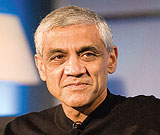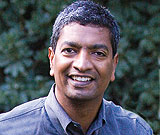The thing I love most about America is that there is always somebody who doesn’t get the word somebody who doesn’t understand that in a Great Recession you’re supposed to hunker down, downsize and just hold on for dear life. I have a couple of friends who fit that bill, who think a recession is a dandy time to try to discover better and cheaper ways to do things.
They both happen to be Indian-Americans one a son of the Himalayas, who came to America on a scholarship and went to work for NASA to try to find a way to Mars; the other a son of New Delhi, who came here and found the Sun, Sun Microsystems. Both are serial innovators. Both are now shepherding clean-tech start-ups that have the potential to be disruptive game changers. They don’t know from hunkering down. They just didn’t get the word.
|
They both happen to be Indian-Americans one a son of the Himalayas, who came to America on a scholarship and went to work for NASA to try to find a way to Mars; the other a son of New Delhi, who came here and found the Sun, Sun Microsystems |
As a result, one has produced a fuel cell that can turn natural gas or natural grass into electricity; the other has a technology that might make coal the cleanest, cheapest energy source by turning its carbon-dioxide emissions into bricks to build your next house. Though our country may be flagging, it’s because of innovators like these that you should never ever write us off.
 |
 |
| Vinod Khosla, Co-founder of Sun |
K.R. Sridhar, Co-founder and C.E.O of Bloom Energy |
Let me introduce Vinod Khosla and K.R. Sridhar. Khosla, the co-founder of Sun, set out several years ago to fund energy start-ups. His favorite baby right now is a company called Calera, which was begun with the Stanford Professor Brent Constantz, who was studying how corals use CO2 to produce their calcium carbonate bones.
If you combine CO2 with seawater, or any kind of briny water, you produce CaCO3, calcium carbonate. That is not only the stuff of corals. It is also the same white, pasty goop that appears on your shower head from hard (calcium-rich) water. At its demonstration plant near Santa Cruz, Calif., Calera has developed a process that takes CO2 emissions from a coal- or gas-fired power plant and sprays seawater into it and naturally converts most of the CO2 into calcium carbonate, which is then spray-dried into cement or shaped into little pellets that can be used as concrete aggregates for building walls or highways instead of letting the CO2 emissions go into the atmosphere and produce climate change.
|
Our politics has gotten so impossible lately, too many Americans have stopped dreaming. Not these two. They just never got the word. As Sridhar says: We came to America for the American dream to do good and to make good |
If this can scale, it would eliminate the need for expensive carbon-sequestration facilities planned to be built alongside coal-fired power plants and it might actually make the heretofore specious notion of clean coal a possibility.
In announcing in December an alliance to build more Calera plants, Ian Copeland, president of Bechtel Renewables and New Technology a tough-minded engineering company said: The fundamental chemistry and physics of the Calera process are based on sound scientific principles and its core technology and equipment can be integrated with base power plants very effectively.
A source says the huge Peabody coal company will announce an investment in Calera next week. If this works, said Khosla, coal-fired power would become more than 100 percent clean. Not only would it not emit any CO2, but by producing clean water and cement as a byproduct it would also be taking all of the CO2 that goes into making those products out of the atmosphere.
John Doerr, the legendary venture capitalist who financed Sun, once said of Khosla: The best way to get Vinod to do something is to tell him it is impossible.
Sridhar’s company, Bloom Energy, was featured last week on CBS’s 60 Minutes. Several months ago, though, Sridhar took me into the parking lot behind Google’s Silicon Valley headquarters and showed me the inside of one of his Bloom Boxes, the size of a small shipping container. Inside were stacks of solid oxide fuel cells, stored in cylinders, and all kinds of whiz-bang parts that I did not understand.
What I did understand, though, was that Google was already getting part of its clean-energy from these fuel cells and Wal-Mart, eBay, FedEx and Coca-Cola just announced that they are doing the same. Sridhar, Bloom’s co-founder and C.E.O., said his fuel cells, which can run on natural gas or biogas, can generate electricity at 8 to 10 cents a kilowatt hour, with today’s subsidies. ‘We know we can bring the price down further,’ he said, so Bloom power will be affordable in every energy-poor country Sridhar’s real dream.
Attention: These technologies still have to prove that they are reliable, durable and scalable and if you Google both, you will find studies saying they are and studies that are skeptical. All I know is this: If we put a simple price on carbon, these new technologies would have a chance to blossom and thousands more would come out of innovators’ garages. America still has the best innovation culture in the world. But we need better policies to nurture it, better infrastructure to enable it and more open doors to bring others here to try it.
Our politics has gotten so impossible lately, too many Americans have stopped dreaming. Not these two. They just never got the word. As Sridhar says: We came to America for the American dream to do good and to make good.
—Courtesy: The New York Times
|